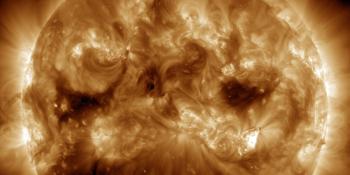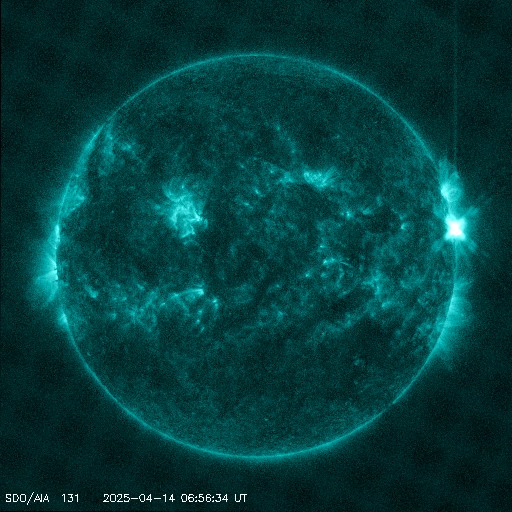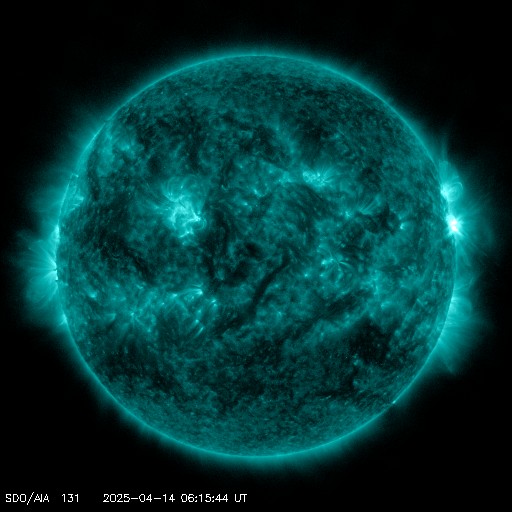Viewing archive of Friday, 13 April 2001
Solar activity report
Any mentioned solar flare in this report has a scaling factor applied by the Space Weather Prediction Center (SWPC). Because of the SWPC scaling factor, solar flares are reported as 42% smaller than for the science quality data. The scaling factor has been removed from our archived solar flare data to reflect the true physical units.
Report of Solar-Geophysical Activity 2001 Apr 13 2200 UTCPrepared by the NOAA © SWPC and processed by SpaceWeatherLive.com
Joint USAF/NOAA Report of Solar and Geophysical Activity
SDF Number 103 Issued at 2200Z on 13 Apr 2001IA. Analysis of Solar Active Regions and Activity from 12-2100Z to 13-2100Z
Solar activity was very low. Region 9415 (S22W59)
declined in size and number of spots during the period. This region
still retains a beta-gamma-delta magnetic configuration and is still
capable of producing M and X-class events. Region 9418 (N26W46)
developed into a more magnetically complex beta-gamma configuration,
however it produced very little activity today.
IB. Solar Activity Forecast
Solar activity is expected to be low
to moderate. Region 9415 is still capable of producing another major
flare before it rotates over the western limb.
IIA. Geophysical Activity Summary 12-2100Z to 13-2100Z
The geomagnetic field was at quiet to severe storm levels. A coronal
mass ejection (CME), from an M2 flare on 11 April, impacted earth at
13/0735 UTC. A sudden impact of 19 nT was detected at the Boulder
USGS magnetometer. The resulting disturbance caused major and severe
geomagnetic storm conditions from 13/1900-2100 UTC, and minor to
major storm conditions from 13/1200-1500 UTC. Conditions subsided to
active levels for the remainder of the period. The greater than 10
MeV proton event ended at 13/1800 UTC. The polar cap absorption
event (PCA) ended during the period.
IIB. Geophysical Activity Forecast
The geomagnetic field is
expected to be unsettled to minor storming for the first two days of
the period. These conditions will be the result of another impact at
earth of a CME. This CME originated from an X2 event on 12 April.
The expected arrival time is mid to late 14 April and at onset could
cause major storm levels, with brief severe storm levels at high
latitudes possible. Conditions should subside to quiet to active
levels on the third day.
III. Event Probabilities 14 Apr to 16 Apr
| Class M | 80% | 70% | 60% |
| Class X | 25% | 15% | 10% |
| Proton | 25% | 15% | 10% |
| PCAF | green | ||
IV. Penticton 10.7 cm Flux
Observed 13 Apr 137 Predicted 14 Apr-16 Apr 135/130/140 90 Day Mean 13 Apr 166
V. Geomagnetic A Indices
Observed Afr/Ap 12 Apr 029/038 Estimated Afr/Ap 13 Apr 025/035 Predicted Afr/Ap 14 Apr-16 Apr 050/055-025/030-015/015
VI. Geomagnetic Activity Probabilities 14 Apr to 16 Apr
| A. Middle Latitudes | |||
|---|---|---|---|
| Active | 25% | 35% | 25% |
| Minor storm | 40% | 15% | 10% |
| Major-severe storm | 30% | 10% | 06% |
| B. High Latitudes | |||
|---|---|---|---|
| Active | 25% | 35% | 35% |
| Minor storm | 30% | 25% | 20% |
| Major-severe storm | 40% | 20% | 12% |
All times in UTC
Current data suggests there is a slight possibility for aurora to appear at the following high latitude regions in the near future
Gillam, MB, Yellowknife, NTLatest news
Latest forum messages
Filaments and prominences 622025/04/12-13 Filament CMEs 2025/04/16 G2 Watch 48Ask your obscure/"stupid" space weather questions. 351Incoming & Unnumbered Active Regions 1708AR 4055 99
More topicsSupport SpaceWeatherLive.com!
A lot of people come to SpaceWeatherLive to follow the Sun's activity or if there is aurora to be seen, but with more traffic comes higher server costs. Consider a donation if you enjoy SpaceWeatherLive so we can keep the website online!

Latest alerts
Monday, 14 April 2025
23:15 UTC - Geomagnetic activity
Active geomagnetic conditions (Kp4) Threshold Reached: 23:01 UTC
07:09 UTC - Solar flare
Moderate M4.28 flare from sunspot region 4055
06:48 UTC - Radio Blackout
Minor R1 radio blackout in progress (≥M1 - current: M1.53)
06:24 UTC - Solar flare
Moderate M1.49 flare from sunspot region 4055
06:06 UTC - Radio Blackout
Minor R1 radio blackout in progress (≥M1 - current: M1.16)
Space weather facts
| Last X-flare | 2025/03/28 | X1.1 |
| Last M-flare | 2025/04/14 | M4.2 |
| Last geomagnetic storm | 2025/04/06 | Kp5 (G1) |
| Spotless days | |
|---|---|
| Last spotless day | 2022/06/08 |
| Monthly mean Sunspot Number | |
|---|---|
| March 2025 | 134.2 -20.4 |
| April 2025 | 128.8 -5.4 |
| Last 30 days | 129.1 -15.1 |





